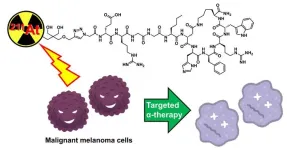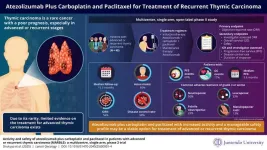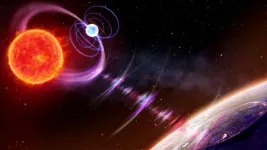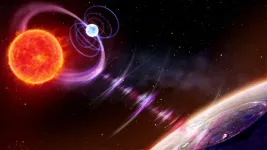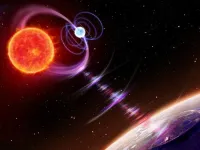(Press-News.org) "UNCG philosopher of biology Dr. Derek Skillings is the lead investigator on a new, three-year, $600,000 grant from the John Templeton Foundation for a study of the emergence and evolution of goal-directed behavior in collective entities.
“A holobiont is a term for a host organism and all of the things that live inside of it and on it,” says Skillings, who is an assistant professor of philosophy at UNCG with adjunct positions in biology and geography, environment, and sustainability.
Examples of collective entities include simple biofilms and massive coral reefs.
“We used to think these weird things like corals, lichens, and maybe certain insects, which are amalgamations of symbioses, were the exception in nature. But now we are realizing no, actually, it’s probably everything. Everything is a holobiont.”
Skillings points to the bacteria in our guts and on our skin, even the mitochondria in our cells, as evidence that humans – like corals and cows – are holobionts. From one perspective, a human is a unified organism. From another, each of us is an ecosystem unto ourselves.
These concepts can impact how we think about human diet and health, a major focus of the first grant, as well as how we understand biological and ecological systems for conservation.
The research team includes Dr. Ben Allen of Emmanuel College, Dr. Rory Smead of Northeastern University, and Dr. Patrick Forber of Tufts University.
Allen is a mathematician who creates models to predict how cooperative behavior develops in groups. Smead is a philosopher who specializes in game theory and agent-based models derived from economics. Forber is a philosopher of biology who, together with Smead, has studied how spiteful behavior may have evolved in humans to foster group cooperation over time.
“We’ve found there is a really cool, similar set of problems between cooperative behavior in single populations and these multi-species interactions we find in holobionts,” Skillings says.
In addition to formal philosophical inquiry and mathematical modeling, the new grant will support a series of weeklong events bringing more philosophers and biologists together to broaden the conversation.
“When you bring people together like this, you make space available for cool things to happen,” says Skillings. “Not only do you come up with solutions you hadn’t imagined, but you also come up with problems you didn’t even know existed.""
This grant, which is the largest ever awarded to UNCG’s Department of Philosophy, is Skillings’ second from the Templeton Foundation. His first focused on understanding the physiology, ecology, and evolution of holobiont systems.
This project was made possible through the support of grant #63454 from the John Templeton Foundation. Founded in 1987, the John Templeton Foundation supports interdisciplinary research and catalyzes conversations that inspire awe and wonder. "
END
UNCG professor investigates how symbiotic groups can behave like single organisms with $600,000 in Templeton Foundation funding
2025-03-12
ELSE PRESS RELEASES FROM THIS DATE:
Targeted alpha therapy: a breakthrough in treating refractory skin cancer
2025-03-12
Metastatic melanoma, also known as stage IV melanoma, is a type of skin cancer that spreads to other parts of the body. It is one of the most aggressive forms of skin cancer, with current therapies—including immunotherapy and targeted drugs—showing limited effectiveness. Radiotherapy is an emerging treatment for melanoma, but conventional beta-emitting radionuclide therapies have limitations due to their low energy transfer and long-range radiation, which can cause unintended damage to healthy tissues.
To enhance the efficacy of radiotherapy, a research team from Japan, led by Assistant Professor Hiroyuki Suzuki ...
Transforming thymic carcinoma treatment with a dual approach
2025-03-12
Thymic epithelial tumors are a rare group of malignancies originating in the thymus gland, that includes thymoma and thymic carcinoma. Among these, thymic carcinoma is the more aggressive subtype, characterized by high invasiveness, metastatic potential, and poor prognosis. With an incidence of just 0.15 cases per 100,000 person-years, its rarity poses significant challenges for treatment development. While platinum-based chemotherapy remains the current standard of care, its efficacy is limited. Immune checkpoint inhibitors have shown promise in pretreated cases, but durable ...
Wrong on skin cares: keratinocytes, not fibroblasts, make collagen for healthy skin
2025-03-12
The skin consists of two primary layers. The epidermis, the outermost layer, is predominantly made up of keratinocytes, while the deeper dermis contains blood vessels, nerves, and structural proteins such as collagen, which give the skin its strength and texture. Traditionally, fibroblasts—specialized supporting cells within the dermis—have been believed to play a key role in producing collagen.
In humans, collagen is formed before and after birth. It has been believed that fibroblasts play an exclusive role in collagen production in the skin, and no keratinocytes contribute to collagen production. The statement “Collagen production in the human skin is achieved by fibroblasts” ...
Delhi air pollution worse than expected as water vapour skews figures
2025-03-12
New Delhi's air pollution is more severe than previously estimated with particles absorbing atmospheric water vapour leading to particulate matter levels across the city being underestimated by up to 20%, a new study reveals.
Hygroscopic growth causes fine particulate matter (PM1) to swell, reducing sampling devices efficiency and leading to underestimation, with greatest underestimation in estimated concentrations happening during winter morning rush hours, when humidity is highest and pollution is most severe.
In contrast, research shows that the monsoon ...
First radio pulses traced to dead-star binary
2025-03-12
An international team of astronomers, including a Northwestern University astrophysicist, has traced a series of mysterious radio pulses to an unprecedented home.
Starting a decade ago, astronomers have detected a pulse of radio emission every two hours, coming from the direction of the Big Dipper. After combining observations from multiple telescopes, the team can now reveal the culprit: a binary system with a dead star.
According to the new study, a red dwarf and white dwarf are orbiting each other so tightly that their magnetic fields interact. Each time they bump together — which is every two hours — the interaction emits a long radio blast.
Although astronomers ...
New membrane discovery makes possible cleaner lithium extraction
2025-03-12
Researchers have developed a new process for sustainable lithium extraction, which could help to address the growing global demand for the metals used in electric vehicle batteries and renewable energy storage.
Current ways of getting lithium are bad for the environment and more sustainable approaches are hard to perform on a large scale, but scientists have developed new membranes to pull lithium directly out of salty lake water using electricity, leaving other metal ions behind.
Publishing their findings in Nature Water today (12 Mar), the international group of researchers from the UK, France, ...
Entwined dwarf stars reveal their location thanks to repeated radio bursts
2025-03-12
An international team of astronomers led by Dr Iris de Ruiter, now at the University of Sydney, has shown that a white dwarf and a red dwarf star orbiting each other every two hours are emitting radio pulses.
Thanks to follow-up observations using optical and x-ray telescopes, the researchers were able to determine the origin of these pulses with certainty. The findings explain the source of such radio emissions found across the Milky Way galaxy for the first time.
The results are published in Nature Astronomy.
In recent years, better analysis techniques have given researchers the ability ...
Landscape scale pesticide pollution detected in the Upper Rhine region, from agricultural lowlands to remote areas
2025-03-12
A recent study by the RPTU University Kaiserslautern-Landau shows extensive pesticide contamination in the landscape of the Upper Rhine Region. The research team led by Carsten Brühl shows for the first time that synthetic chemical pesticides from conventional agriculture do not remain on the cultivated areas, but spread from the lowlands to the Black Forest and the Palatinate Forest. The results show that the entire landscape is contaminated with pesticide mixtures, shedding new light on the potential environmental ...
Decoding nanomaterial phase transitions with tiny drums
2025-03-12
When water freezes into ice or boils into vapour, its properties change dramatically at specific temperatures. These so-called phase transitions are fundamental to understanding materials. But how do such transitions behave in nanomaterials? In Nature Communications, a team of scientists led by TU Delft (The Netherlands) presents new insights into the complex nature of phase transitions in magnetic nanomaterials. Their findings reveal the coupling between magnetic and mechanical properties, paving the way for ultra-sensitive sensors.
The scientists from TU Delft, together with colleagues from the University of Valencia and the National University of Singapore, studied ...
Two-star system explains unusual astrophysical phenomenon
2025-03-12
(Images available via the links in the Notes section) An international team of astrophysicists led by the Netherlands and the UK have discovered that radio pulses lasting seconds to minutes are due to two stars coming together – rather than emissions from a single star. The results are published today (12 March) in Nature Astronomy.
In recent years, a new astronomical phenomenon has puzzled radio astronomers: researchers have detected radio pulses from the Milky Way that last from seconds to minutes. These pulses are unlike anything expected from known radio-emitting neutron stars, or pulsars*, ...
